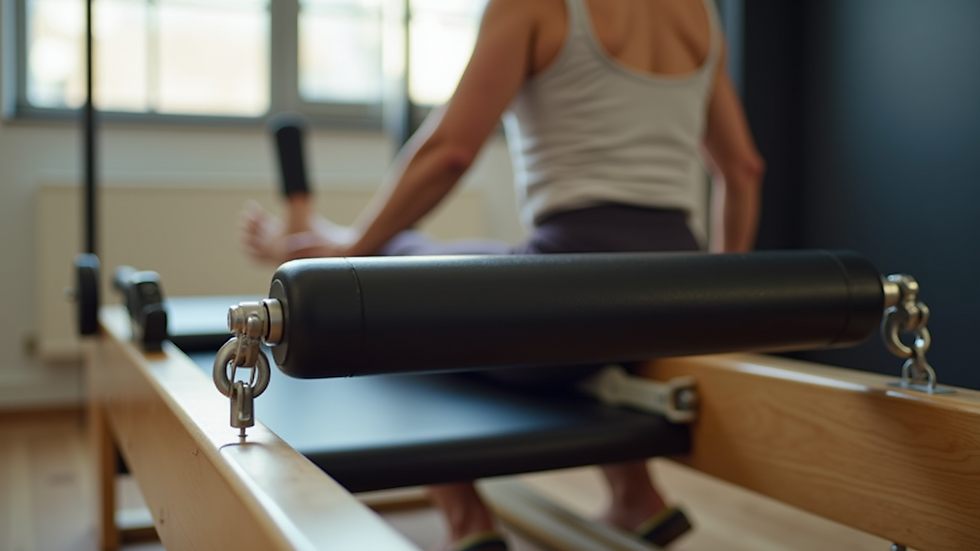Unlocking Better Flexibility Through Pilates
- Eugenia Mima Leal

- Oct 19
- 3 min read
Flexibility is a key component of overall fitness and well-being. It allows your body to move freely, reduces the risk of injury, and improves posture and balance. Many people struggle with tight muscles and limited range of motion, which can affect daily activities and athletic performance. Fortunately, there is a gentle yet effective way to enhance flexibility - Pilates. This blog post explores how Pilates flexibility exercises can unlock better flexibility, improve your body awareness, and promote long-term health.
Understanding Flexibility Exercises and Their Importance
Flexibility exercises are designed to stretch muscles and tendons, increasing the range of motion in joints. These exercises help maintain muscle elasticity and joint mobility, which are essential for functional movement. Regular flexibility training can:
Reduce muscle stiffness and soreness
Improve circulation and nutrient delivery to tissues
Enhance athletic performance by allowing greater movement efficiency
Prevent injuries by preparing muscles and joints for physical activity
Promote relaxation and reduce stress through mindful stretching
Flexibility exercises can be static (holding a stretch) or dynamic (moving through a range of motion). Incorporating both types into your routine ensures balanced muscle development and joint health.

How Pilates Flexibility Exercises Differ from Traditional Stretching
Pilates flexibility exercises focus not only on stretching but also on strengthening the muscles that support your joints. Unlike traditional stretching, Pilates emphasizes controlled movements, breath coordination, and core engagement. This approach helps improve flexibility while building stability and alignment.
Key features of Pilates flexibility exercises include:
Controlled Movements: Each stretch is performed with precision to avoid overstretching or injury.
Core Activation: Engaging the core muscles supports the spine and pelvis, enhancing overall posture.
Breath Awareness: Coordinated breathing helps relax muscles and deepen stretches.
Balanced Muscle Development: Pilates targets both agonist and antagonist muscles to prevent imbalances.
For example, the Pilates spine stretch forward not only lengthens the hamstrings and back muscles but also strengthens the abdominal muscles, promoting better posture and flexibility.

Can Pilates Help with Flexibility?
Yes, Pilates can significantly improve flexibility when practiced consistently. The method combines stretching with strengthening, which is essential for sustainable flexibility gains. Pilates exercises lengthen tight muscles while strengthening weak ones, creating a balanced and flexible body.
Research and anecdotal evidence show that Pilates helps:
Increase joint range of motion
Reduce muscle tightness and tension
Improve muscle elasticity and length
Enhance body awareness and movement control
For instance, exercises like the Saw and the Mermaid stretch the spine and sides of the body, improving lateral flexibility. The controlled nature of Pilates also reduces the risk of overstretching, making it suitable for all fitness levels.
If you want to explore more about how to incorporate Pilates into your routine, consider checking out pilates for flexibility for expert guidance and tailored programs.

Practical Tips to Maximize Flexibility Gains with Pilates
To get the most out of Pilates flexibility exercises, follow these practical tips:
Consistency is Key: Practice Pilates at least 2-3 times per week to see noticeable improvements.
Warm Up Properly: Begin with gentle movements to prepare your muscles and joints.
Focus on Breath: Use deep, controlled breathing to relax muscles and enhance stretch depth.
Engage Your Core: Maintain core activation to support your spine and improve posture.
Listen to Your Body: Avoid pushing into pain; flexibility improves gradually.
Use Props if Needed: Pilates equipment like reformers, bands, or balls can assist in achieving better stretches.
Combine with Other Activities: Complement Pilates with light cardio or strength training for overall fitness.
By integrating these tips, you can safely and effectively unlock better flexibility through Pilates.
Embracing a Flexible Lifestyle Beyond Pilates
Flexibility is not just about exercise; it’s a lifestyle choice that promotes movement freedom and well-being. To maintain and enhance your flexibility gains from Pilates, consider these lifestyle habits:
Stay Hydrated: Proper hydration keeps muscles supple.
Maintain Good Posture: Avoid prolonged sitting or poor ergonomics.
Incorporate Movement Breaks: Stretch or move every hour if you have a sedentary job.
Eat a Balanced Diet: Nutrients like magnesium and vitamin D support muscle function.
Manage Stress: Practice mindfulness or meditation to reduce muscle tension.
By adopting these habits, you support your body’s flexibility and overall health long-term.
Unlocking better flexibility through Pilates flexibility exercises is a rewarding journey that enhances your physical and mental well-being. With dedication and mindful practice, you can enjoy a more agile, balanced, and pain-free body.




Comments